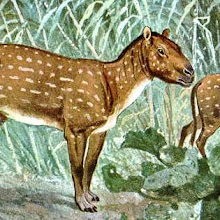Now I will be discussing my favorite dinosaur, the Compsognathus. It lived in the late Jurassic and is the only Dinosaur I think I will be discussing for a while. Compsognathus' name comes from "compsos," which comes from the Greek word for dainty, elegant, or refined and "gnathos," which means "jaw," also from Greek. That isn't the kind of name you would expect a carnivore to have. But, the name probably comes from its small size. That is probably why I like it. Its DNA is quite similar to that of the Archaeopteryx, and pterysaurs such as Pterydactylus It was estimated to be 3 feet in length and weigh 6.5 lbs. It was first found in Deutschland in Bayern. For those of you who do not speak Deutsch, and NO, it is not Dutch, with technology the way it is, you can translate it, so get used to it. The Compsognathus fossil found in Bayern was about the size of a chicken, so they called it a chicken-sized dinosaur. This is not correct because of another nearly complete skeleton found in Canjuers, France. This skeleton was about the size I described earlier. Now, it is assumed that the first skeleton was a juvenile. Also, in the places where they found this dinosaur, they found it near marine organisms. It is also assumed that at this time, Europe was a tropical archipelago. In addition, no other dinosaurs were found with it. This makes people think that it lived on a tropical island where it was the top land predator. If this is true, it could account for its small size. This is because of insular dwarfism. When there was little competition, it could adapt by becoming smaller so it wouldn’t have to eat as much food. This is opposed to Island gigantism, where the animals become larger because they don’t have to hide from predators, but if predators are introduced, they are the first to go. I do not know why some grow larger and some smaller, that’s meiosis for you. The Compsognathus’ diet can only be guessed at, due to there being both aquatic and terrestrial life that could be eaten. The Deutsch fossil had a smaller dinosaur being digested. Hey, I said it was probably the largest, not the only one. The dinosaur, Bavarisaurus, that it was eating was fast and agile , so scientists guess that Compsognathus’ eyesight was sharp and that it could quickly accelerate. Now that I am done talking about my favorite dinosaur, I do not plan on returning to the Mezozoic era anytime soon. Instead I will discuss two more ancient Cenozoic vertabrates, a mammal and a bird.

No comments:
Post a Comment